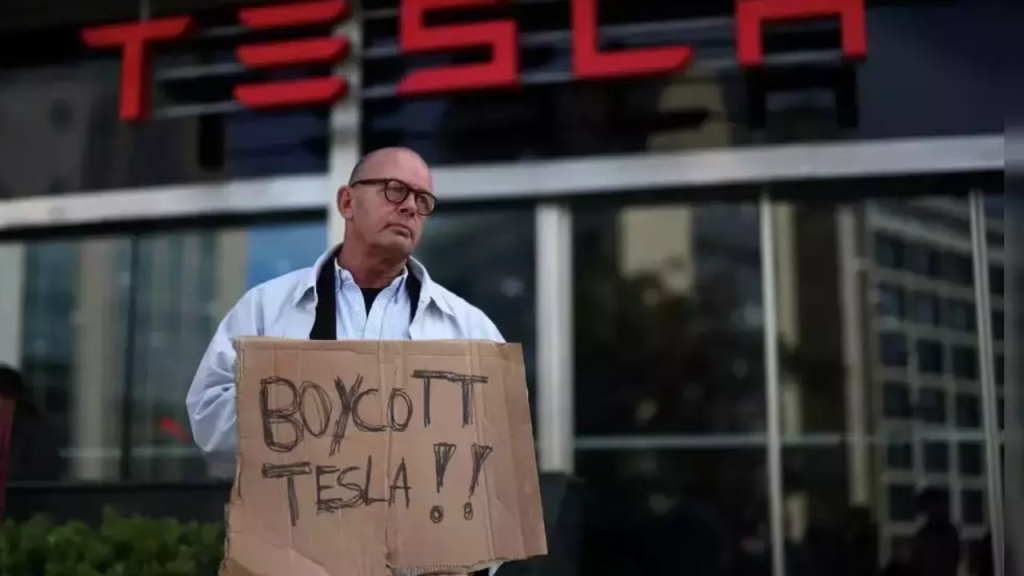
Americans angry over Elon Musk’s sweeping cuts to federal services aren’t just venting online — they’re showing up in person. Across the country, frustrated citizens are staging demonstrations outside Tesla showrooms, and it’s starting to rattle Musk.
“Who is funding and organizing all these paid protests?” he complained on X, referring to the nationwide “Tesla Takedown” protests.
But maybe Musk should be asking a different question: “Who designed my showrooms to be so protest-friendly?” The answer? Elon Musk himself.
While traditional car dealerships are typically located on the outskirts of cities, Tesla flipped the script. Of the 276 Tesla showrooms in the U.S., most sit right in the heart of affluent, bustling neighborhoods—often where wealthy progressives live, shop, and dine. It was a brilliant move for visibility and sales, but now it’s proving to be a public relations nightmare.
Musk had his reasons. First, to sidestep state laws that block direct-to-consumer car sales, Tesla rebranded showrooms as “galleries.” You can’t buy a Tesla on the spot—sales happen online.
That allowed Tesla to avoid the sprawling lots and commission-driven salespeople associated with traditional dealerships. “Our stores,” Musk boasted back in 2012, “are designed to be informative and interactive in a delightful way.”
Second, Tesla’s core audience has always been affluent, urban progressives—early adopters more likely to embrace electric vehicles.
So naturally, Tesla placed its showrooms in high-traffic, high-visibility areas like malls and trendy shopping streets, where potential buyers are already out and about in a relaxed, consumer-friendly mindset.
But that strategy came with unintended consequences.
The American Communities Project, which maps demographic data by county, confirms that over half of Tesla’s U.S. showrooms are in big cities or dense suburbs.
Even deeper analysis from the National Zoning Atlas reveals most are located in “inner suburbs”—a relatively small slice of neighborhoods that nonetheless host the majority of Tesla showrooms.
In other words, Tesla planted itself right in the heart of areas filled with highly educated, higher-income, mostly Democratic-leaning Americans—the exact demographic now protesting Musk’s recent actions.
Dan Crane, a University of Michigan law professor and author of the upcoming book Direct Hit: How Tesla Went Straight to Consumers and Smashed the Car Dealers’ Monopoly, says it best: “Just when they won, it seems like they’re finding a way to lose now.”
With sales declining, Cybertrucks going up in flames, and Tesla’s stock down more than 30% this year, he argues that Tesla’s once-clever retail strategy has turned into a liability. “Their retail strategy made them sitting ducks.”
Protests outside car dealerships aren’t new. In the early 2000s, eco-activists even blew up Hummers in protest. But Tesla’s urban showrooms are different.
Unlike the remote lots of other brands, Tesla’s locations are in walkable, vibrant areas, often close to busy sidewalks—prime spots for legal, visible demonstrations.
Dana Fisher, a sociologist at American University and author of American Resistance, points out that this proximity to public spaces gives protesters a real advantage.
“The goal here is shaming consumers about their purchasing decisions,” she says. “To protest a brand, it’s great to be able to go to a dealership.”
By contrast, protesting a Trump property wouldn’t have the same effect—they’re too isolated, and their clientele has already made up its mind. But Tesla showrooms? They’re out in the open, easy to access, and conveniently listed right on Tesla’s website.
Patrice Kopistansky, a retired government lawyer helping organize protests in Virginia, puts it plainly: “Tesla facilities are the most common, visible symbols of Elon Musk—and Elon Musk is the face of this administration’s cruelty and incompetence.”
She says location matters. The Tesla store in Tyson’s Corner, for example, is right by the sidewalk, unlike other nearby luxury car dealerships that are set back behind large parking lots. “I don’t know why they built it like that,” she admits. “They’ve probably come to regret it.”
Protesters at that location have even started handing out bumper stickers to passing drivers at nearby lights: “Sorry, I bought a Tesla!”
